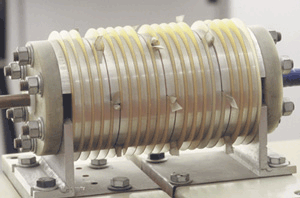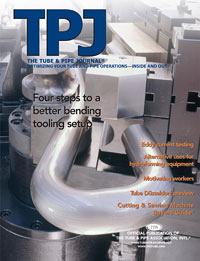- FMA
- The Fabricator
- FABTECH
- Canadian Metalworking
Categories
- Additive Manufacturing
- Aluminum Welding
- Arc Welding
- Assembly and Joining
- Automation and Robotics
- Bending and Forming
- Consumables
- Cutting and Weld Prep
- Electric Vehicles
- En Español
- Finishing
- Hydroforming
- Laser Cutting
- Laser Welding
- Machining
- Manufacturing Software
- Materials Handling
- Metals/Materials
- Oxyfuel Cutting
- Plasma Cutting
- Power Tools
- Punching and Other Holemaking
- Roll Forming
- Safety
- Sawing
- Shearing
- Shop Management
- Testing and Measuring
- Tube and Pipe Fabrication
- Tube and Pipe Production
- Waterjet Cutting
Industry Directory
Webcasts
Podcasts
FAB 40
Advertise
Subscribe
Account Login
Search
Magnetic pulse welding for tubular applications: Discovering new technology for welding conductive materials
- By Ben-Tzion Spitz and Victor Shribman
- July 26, 2001
- Article
- Tube and Pipe Fabrication
Engineers are discovering a variety of applications for a new solid-state welding process known as magnetic pulse welding (MPW). MPW has been theorized and tested for decades, but it is only recently that manufacturers have been exposed to the possibilities of running an MPW system on their lines.
How MPW Works
In MPW, a tremendous amount of energy is compressed and discharged in an extremely short period of time. For example, some systems can discharge as much as 2 million amps in less than 100 microseconds. This causes a large amount of energy to be discharged so quickly that the actual energy expenditure is very low. The electronic system is based on capacitive power, however, because the effect is so fast there is negligible heating of the metal.
The discharged current runs through a coil that surrounds the tubes to be welded. The coil wraps around the parts but does not come into contact with them. The strong current in the coil generates an eddy current in the outer tube, which collapses the outer tube and welds it onto the inner tube.
Both currents create very strong magnetic fields, but in opposing directions, so the magnetic fields repel each other. Because the coil is stronger than the outer tube, the outer tube is moved away from the coil at a high velocity. The velocity is similar to that of explosive welding, as is the resulting material interface structure.
The actual process lasts less than 100 microseconds. The production rate can be customized to between 2 and 10 seconds. No gases, fillers, fluxes, or other material is needed to effect the weld. A gap is needed between the parts for the process to work, so tight tolerances are not a concern.
MPW is a cold process, heating the metal to no more than 30 degrees Celsius. Therefore, no heat-affected zone (HAZ) is created, and the metal is not degraded. The weld becomes the strongest part of the assembly.
What MPW Can Weld
MPW can work on any material that is conductive. The more conductive the part, the less energy is required to achieve a weld. The easiest materials to weld are aluminum and copper—they can be welded to almost anything.
MPW has been successful in welding aluminum to steel. Other dissimilar and similar metals that have been welded successfully include, among many others:
- Aluminum to aluminum.
- Aluminum to copper.
- Aluminum to magnesium.
- Aluminum to titanium.
- Copper to copper.
- Copper to steel.
- Copper to brass.
- Nickel to titanium.
- Nickel to nickel.
- Steel to steel.
Magnetic pulse technology also can be used for joining or crimping parts that do not necessarily need a metallurgical bond, such as a metal to a nonmetallic part. It can create a mechanical lock on ceramics, polymers, rubber, and composites, so adhesives, sealants, and mechanical crimps are not necessary. With the process, metal is basically shrink-wrapped over the components.
Industry Applications
One of the natural applications for MPW is replacement of brazing. In the appliance industry, demand is growing for an alternative method to traditional brazing that reduces the possibility of corrosion. MPW reduces the risk of corrosion by limiting the metallic interaction to just the two metals being welded.
With a slight part redesign, many components that previously were friction-welded can be welded with MPW. In many cases, this allows extruded tubes to be used rather than rods that need to be machined.
Other applications can be found in the automotive industry, ranging from welding of large hydroformed tubes to making vehicle frames to joining small-diameter valves. Other applications include joining cables and air-conditioning tubing, coating exhaust systems, welding car seat tubing, and capping oil filters.
Current Limitations
MPW is limited to tubular geometries and lap joints. Because of the way the process works, it is not possible to create a butt weld with MPW. How-ever, on some parts, the joint can be redesigned to be a lap or even a partial or angled lap joint.
The largest tube size to date that MPW has welded successfully is 5 inches in diameter, although this is not a theoretical limitation. There simply has not been a demand for using the process on larger diameters, so minimal effort has been expended in developing larger-size capabilities.
Likewise, flat or other geometries have not yet been tried. Tubular is the easiest geometry, from both the energy consumption and coil design viewpoints. As long as the tubular part to be moved is closed (for instance, a rectangular tube), a strong eddy current will be generated by the coil. A tube with a slit in it will not have the conductivity necessary and therefore will not react properly.
Furthermore, tubular coils are the most powerful and energy-efficient. Nevertheless, developments are being pursued in MPW's use on other geometries.
Design Considerations
When designing joints for MPW, a few basic principles must be kept in mind:
- Gap—The process needs on average a 1-millimeter gap between the tube surfaces to achieve a successful weld. The reason is that the metal needs time to build up to its terminal speed at impact. If the metals are too close, a good crimp can be achieved, but not a weld.
- Overlap—In general, a minimum of two to three times the thickness of the outer material is needed to achieve a weld. The more room and overlap that are available for MPW, the easier it is.
- Surface preparation—Standard cleaning for comparable welding or brazing processes is sufficient for MPW. The speed of the wave that MPW creates actually breaks down light oxide layers and ejects any dirt from the weld area.
- Access—The joint area generally needs a couple of inches of clearance for the coils to surround the joints. The most commonly used coils are closed coils, into which the part is inserted. This is suitable for parts on which at least one end does not have a diameter much larger than the joint diameter. Openable coils have been developed that can clamp over parts that cannot be inserted into a coil.
Conclusion
MPW has just been introduced to the industrial marketplace, so more time is needed for the manufacturing world to implement it in full force. Preliminary evaluation shows promise for a variety of tube and pipe applications. As with any new technology, the early adapters will bear the brunt of discovering all the pros and cons—but they also may be the first to enjoy the benefits.
About the Authors
About the Publication
subscribe now

The Tube and Pipe Journal became the first magazine dedicated to serving the metal tube and pipe industry in 1990. Today, it remains the only North American publication devoted to this industry, and it has become the most trusted source of information for tube and pipe professionals.
start your free subscription- Stay connected from anywhere

Easily access valuable industry resources now with full access to the digital edition of The Fabricator.

Easily access valuable industry resources now with full access to the digital edition of The Welder.

Easily access valuable industry resources now with full access to the digital edition of The Tube and Pipe Journal.
- Podcasting
- Podcast:
- The Fabricator Podcast
- Published:
- 04/16/2024
- Running Time:
- 63:29
In this episode of The Fabricator Podcast, Caleb Chamberlain, co-founder and CEO of OSH Cut, discusses his company’s...
- Trending Articles
Zekelman Industries to invest $120 million in Arkansas expansion

3D laser tube cutting system available in 3, 4, or 5 kW

Corrosion-inhibiting coating can be peeled off after use

Brushless copper tubing cutter adjusts to ODs up to 2-1/8 in.

HGG Profiling Equipment names area sales manager

- Industry Events
16th Annual Safety Conference
- April 30 - May 1, 2024
- Elgin,
Pipe and Tube Conference
- May 21 - 22, 2024
- Omaha, NE
World-Class Roll Forming Workshop
- June 5 - 6, 2024
- Louisville, KY
Advanced Laser Application Workshop
- June 25 - 27, 2024
- Novi, MI



























